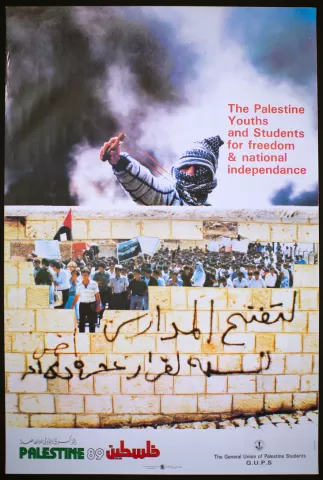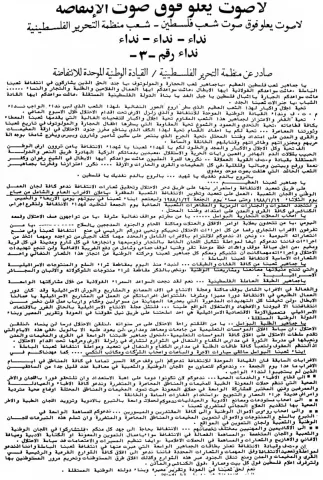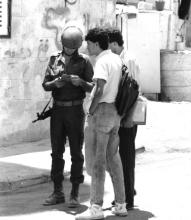On a normal autumn afternoon in 1988, in the living room of a house in the village of Kobar near Ramallah , students gather crisscrossed on the floor mattresses. Shoulders reclining against one another, they focus their attention on their studies while trying to ignore the pleasant smell emanating from the kitchen. The teacher is laboring to remember what she learned in the respective subject some two decades before.
This “school” is unlike most schools. There were no morning single file lines, school bells, or cold gray hallways and windows with metal bars. In the school in Kobar, and in others like it, you would study with your twin brother in the same class. Your aunt would be your teacher, or perhaps your neighbor, who was a university student. The class may move to the garden of your classmate's family if it meant helping them in the harvest. The lesson's topic itself may change, covering the types of crops that can be planted next season, and how one can guard them from insects.
This extraordinary school—and there were many like it—came into being under exceptional circumstances. It was this context which forced Palestinian society in the West Bank , Jerusalem , and Gaza to redistribute its sustenance and reorganize priorities in accordance with the needs of the First Intifada of 1987. Education was one priority that managed to endure the ensuing disruption of daily Palestinian life, and nor was it derailed by the burdens of a phase which proclaimed confrontation as its main slogan.
The story of popular education, which emerged as a mechanism of adapting to the constant Israeli attacks on Palestinian education, is exemplary of the social solidarity that distinguished the First Intifada. It dissolved the distinctions between the realms of military, formal, and popular resistance, allowing all sectors of society to take on different roles in confrontation.
Institutions in Revolt
The first appearance of the educational sector as a part of the nascent Intifada was through the participation of school and university youths, who comprised the revolutionary lifeblood of the uprising. With the start of the Intifada on December 1987, there were more than half a million school students and more than twenty thousand university students in the West Bank and Gaza.1 They were no exception to the rule of Israeli suppression and the subsequent wave of revolutionary upheaval which came as a response to it.
In the first year of the Intifada, 166 students were martyred. In fact, more than half of the martyrs of the Intifada were students. Their involvement in the struggle exacted a significant toll, from arrests, to travel bans, to injuries, and to exile.2
Of the approximately 17,000 teachers in the West Bank, Gaza, and Jerusalem, 790 were incarcerated, and many were also exiled or martyred. This was coupled with arbitrary dismissal and forced referrals for retirement. Moreover, salary deductions were made for over 8,000 teachers.3

Alongside the students themselves, the educational institutions established by popular initiative became direct targets for the various forms of repression, especially since they served the function of fostering future revolutionaries. Many schools were exposed to violent raids as was the case of Dar al-Tifil, Dar al-Fata Al-laji'a, and Dar al-Awlad in 1988 in Jerusalem. These incursions also resulted in the assault of faculty members, as has happened in the two schools of Falastin al-Thanawiyya and Ibn Sina in Gaza.4
Tens of schools, sometimes simultaneously, were forced to close partially or completely, for periods that would occasionally reach more than 100 days.5 On occasion, these closed schools would come under direct military control. Israeli forces turned more than 40 schools into military bases used for combat and so-called security purposes. Often such thievery coincided with the tampering, burning, and complete destruction of school property, as well as of anti-Arab slogans sprayed inside the classrooms.6
The targeting of schools and universities was almost blunt in its message: education threatens the security of Israel. In media discourse, Israel repeatedly claimed that the closing down of schools decreased the rate of “violence and riots” in the “Territories.” A review of the correlation between school closures and Palestinian resistance efforts refutes this claim. Zionist colonel Aryeh Schlaff, former Israeli army spokesperson, who closely followed the events of the Intifada, divulged this information in his book “Intifada: Causes, Features and Effects.”
According to Schlaff, the number of resistance efforts did not decline after February 1988 (that is, after the mass closure of schools). Moreover, the number did not increase after the reopening of schools in April of the same year; on the contrary, it decreased. However, there was an evident rise after July, when schools were not closed consistently and education was tentative. As a result, the number of operations rose from 1997 in August to 2438 in September and declined once more in October and November when schools returned to stability. However, once more, the number of operations escalated with the end of the year and did not decline with the decision to close schools again in 1989.
These comparisons highlight that the closure of schools did not affect the momentum of the Palestinian uprising. Instead, it was a tool of collective punishment that the occupation enforced on Palestinian society in its various sectors. Furthermore, the reopening of schools was not the result of a decline in the momentum of resistance efforts, but rather a reaction to the rise of what was called “popular education.”7
"Open Schools"
1989
From the Ali Kazak collection. © the Palestinian Museum

Defeating the “policies of miseducation”
In the early months of the uprising, the effects of perpetual school closure and lack of stability began to take its tool. It went beyond children's boredom or their parents' frustration. It was obvious that the void created by the absence of consistent schooling had to be filled quickly.

The Communiques of the Intifada, which were an important platform in directing efforts towards the struggle, were issued by theUnified National Leadership of the Uprising (UNLU). During the initial period of school closures, these statements reflected a desire to bring students and academics to the revolutionary crowd and to benefit the struggle with their energies. This manifested in open calls, as with the uprising's third statement, which called for the mobilization of student masses “in the revolutionary schools, in the schools of struggle in the streets, to contribute to shaking the earth and burning underneath the soles of the occupation.”
Many students responded to these calls, if they had not already preempted them. But this kind of participation in struggle did not negate the realization that it was necessary for students to complete their education. The leadership was acutely aware of the dangers and long-term consequences of neglecting the education of an entire generation. This awareness was reflected in the tenth statement of the UNLU in March 1988: “One of the main pillars of Zionist policy is making our people ignorant and depriving them of the most basic rights stipulated in international conventions, the right to education. As such, the occupation's authorities have proceeded with closing all our educational institutions, including universities, higher institutes, and schools. Through this, it has deprived approximately three million students from receiving education. The Intifada's Unified National Leadership has decided to confront the occupation's racist policies by breaking these decisions. It invites students, teachers, and the administrators of educational institutions [...] to defy the decision of the occupation's authorities by organizing an educational process on a national basis, to thwart the policy of miseducation enacted on our people.”
This attempt to fill the educational vacuum surpassed “thwarting of the policy of miseducation,” becoming a historical experience in alternative forms of pedagogy—one that is communal and flexible, through programs created by the teachers and students themselves.
Organizationally, the UNLU worked to establish neighborhood schools, which were run by popular education committees under the supervision of the general local committee in the respective camp, area, or neighborhood. These education committees worked towards providing the bare minimum for an educational environment, including safe physical spaces, books, notebooks, and teachers (who were generally volunteers).8
With statements and calls from the Unified National Command calling for the universalization of popular education, neighborhood schools were spreading and beginning to organize. The tenth statement, released on March 10 1988, called for “each region is to set its own time for the start of its schools, institutes, and universities in alignment with its respective circumstances. This is provided that it is limited to three hours from the morning until eleven, as with all other sectors of our struggling people.”

Teachers and educational administrators also adopted this pattern of education. For instance, on April 5 1988, a conference orchestrated by the educational sector's workers' union recommended to adopt and disseminate popular education.9
Education in Struggle
Popular education was not merely a method for maintaining the continuity of education. Rather, the actual curriculum and pedagogies were developed to align with the general revolutionary nature of the time. This resulted in the incorporation of “Palestinianism” in the content of study, making education more relevant to Palestinian identity and the national struggle. The educational process also opened itself to other modes of teaching, such as newspapers, magazines, graffiti, and music. It also placed less importance in conventional evaluation methods such as exams and homework.10
With the spread of popular education to include 40 percent of students in the Occupied Territories,11 and due to the complementarity between education and struggle, it wasn't long before occupation authorities banned the popular committees which oversaw local schools. The occupation authorities regarded any education attempts as hostile and subversive efforts. Under this pretext, the authorities closed the Friends Association of al-Najah University for two years. They also confiscated library cards from the Islamic University's library in an attempt at identifying the names of students enrolled in special education courses.12
In the village of Kobar, a group of 12-14 individuals transformed a number of old rooms into classrooms, moving from house to house and inviting students to join them. The teachers were women and mothers from the village who never had any experience in teaching. The students, often of varying ages in the same class, would take turns in standing guard to watch for the arrival of the military in search of forbidden gatherings.
The flexibility of these schools was the most important demonstration of their revolutionary essence. For instance, when some girls would have to miss class to help their families in the field, the entire class would often move there. The content of the actual lessons included farming and the relationship of the farmer to the land. The students would deal with the publications of resistance organizations such as the UNLU as reading materials, using them as grammar practice in their Arabic language classes, and then proceeding to discuss their content in their political science classes.13
Popular education informed the revolutionary experience of the Intifada, born of the community's desire for confrontation and defiance. It reveals to us the potential that such education can unlock, not only in temporarily replacing formal education, but in exploring more humane pedagogies that are rooted in society.
SELECTED BIBLIOGRAPHY
- 1Al-Zaru, Salah. Al-Ta'lim fi dhil al-Intifada [Teaching in the Intifada]. Hebron: Markaz Abhath, Silsilat al-Dirasat al-Tarbawiyya, no. 4, 1989, p. 15, 22.
- 2Ibid, pp. 48-51.
- 3Ibid, pp. 42-48.
- 4Ibid, p. 39.
- 5Ibid, p. 39.
- 6Ibid, p. 30.
- 7Al-Madhoun, Rub'i. “Hudu' Nisbi Dhahiri [Relative Apparent Calm]” Shu'un Filastiniyya, 183, Beirut: PLO Research Center, 1988, p. 135.
- 8Al-Madhoun, Rub'i. Al-Intifada al-Filastiniyya: al-Haykal al-Tanzimi wa Asalib al-'Amal [The Palestinian Intifada: Organizational Structure and Methods of Action]. Acre: Dar al-Aswar, 1989, p. 39.
- 9Ibid, p. 59.
- 10Yamila, Hussein. The Stone and the Pen: Palestinian Education during the 1987 Intifada. TEACHING IN A TIME OF WAR, PART 2, No. 74, The Radical Teacher. 2005, pp. 19-20.
- 11Al-Madhoun, "Relative Apparent Calm" p. 135.
- 12Al-Zaru. Teaching in the Intifada, pp. 59-60.
- 13Hussein. The Stone and the Pen, pp. 19-20.

